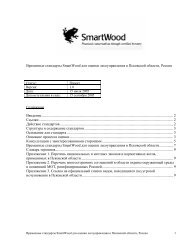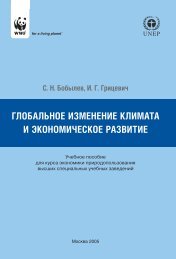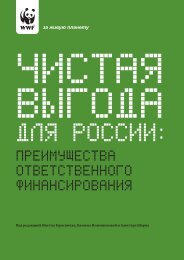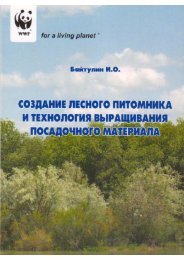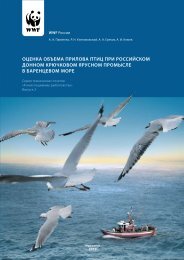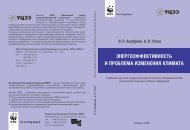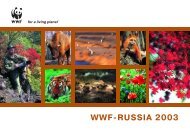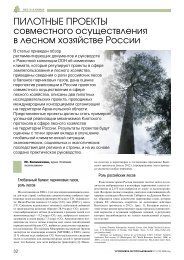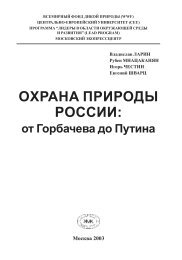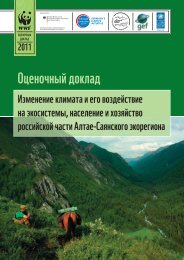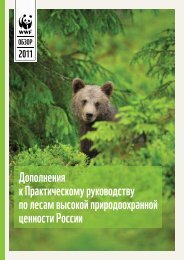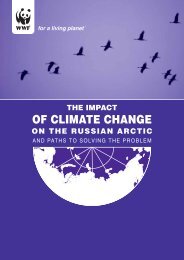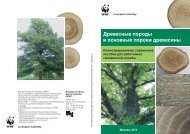Russia-China Timber Trade_cover.jpg
Russia-China Timber Trade_cover.jpg
Russia-China Timber Trade_cover.jpg
Create successful ePaper yourself
Turn your PDF publications into a flip-book with our unique Google optimized e-Paper software.
.Boreal forest comprises over 70% of Eastern Siberian and RFE forests, which are relatively simple in composition,dominated by a few coniferous species such as larch, spruce, fir, and pine. Birch is the dominant broadleavedspecies. These vast boreal forests play a vital role as a carbon sink and in the mitigation of global warming.Biodiversity-rich, temperate, deciduous, and broadleaved forests are located in areas contiguous to Northeast<strong>China</strong> and the coastal zones of the Sea of Japan. These forests have one of the most diverse assemblagesof plant and animal species of any temperate zone on the planet [4]. A mixture of boreal, temperate and subtropicaltree species is seen here. The forests are rich in Korean pine and hardwoods, which have the highestcommercial value in the nearby Northeast Asian markets. Due to the lack of developed infrastructure, vastareas of boreal taiga to the north remain inaccessible. Here, permafrost constrains construction and maintenanceof a road network. To the south, inaccessible areas in mountainous regions, such as the Altay-Sayan andSikhote-Alin Mountain Ranges, have some of the last remaining intact conifer-broadleaved forests[5].Production of forest productsSince 1998, the timber industry in Eastern Siberia and the RFE has gradually rebounded and forest resourceuse has intensified. There are a number of factors behind this rebound, including restructuring of the industryafter the Asian financial crisis and the rise in exports to <strong>China</strong> and Japan [6]. Initially, the <strong>Russia</strong>n timberindustry, local workers, and the regional administrations cheerfully anticipated this re<strong>cover</strong>y and the concomitantimprovements in social and economic standards for forest-dependent regions. But this rebound has resultedin the rapid depletion of commercial timber stocks and widespread environmental degradation – especiallyin regions bordering <strong>China</strong> or those in close proximity to railways and seaports. In return, only paltry revenueshave trickled back into the local economies.Furthermore, the economic rebound has not led to significantly increased ‘value-added’ in the sector. The FarEastern Federal District, which comprises the RFE, remains the most undeveloped when compared to other<strong>Russia</strong>n federal districts. The RFE has very limited paper and cardboard (0.3% of total production), chipboard(0.5%) and fiberboard (2.4%) production, and no production of veneer at all. Production of similar products isobviously underdeveloped in the Siberian Federal District as well (see Table 2). During the Soviet Era, woodprocessing in the RFE was much more developed. Table 3 shows how radically production of sawnwood,veneer, chipboard, fiberboard and pulp decreased in Khabarovskiy Kray, the largest producing region in theRFE, between 1990 and 2004.Table 2.Wood product production in the Siberian and Far Eastern Federal Districts, 2004.Siberian FederalDistrictFar Eastern FederalDistrictRoundwood, mln cu. m 28.5 14.3Sawnwood, mln cu. m 6.0 1.1Veneer, 000 cu. m 165.4 0.5Chipboard, 000.cu. m 389.5 19.3Fiberboard, 00 cu. m 255.9 28.1Paper and cardboard, thousand tons 497.7 21.2Liberalization of the industry also led to an influx of Chinese timber merchants who arrived in depressed <strong>Russia</strong>ntowns seeking to buy timber largely with cash. Shadowy businesses emerged, which supplied timberthrough a dubious mix of illegal logging and corruption. This has fostered a critical situation in <strong>Russia</strong>n regionsbordering <strong>China</strong> because uncontrolled logging, especially of valuable species, led to the devastation of largeforest stands. A detailed analysis of illegal logging in Siberia and the RFE is provided in Section IV.Table 3.Wood Processing in Khabarovskiy Krai, 1990 and 2004.1990 2004Sawnwood, 000 cu. m 1,899 500Veneer, 000 cu. m 5 -Chipboards, 000 cu. m 52 10Fiberboards, 000 cu. m 22,188 -Pulp, thousand tons 264 -7



